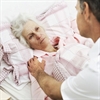 Breathlessness (aka dyspnea) is difficult to manage in palliative care.
Breathlessness (aka dyspnea) is difficult to manage in palliative care.
Researchers in the UK reviewed and ranked the most effective nonpharmacological strategies.
First, the details.
- Evidence supports their use in breathlessness
- Facial cooling, by handheld fan
- Mobility aids (eg, rollators/walkers)
- Neuromuscular electrical stimulation
- Need definition and further research
- Breathing exercises
- Pacing and positioning
- Also…
- Anxiety reduction techniques and carer support act indirectly in chronic disease management and are applicable for breathlessness.
- Exercise is an established strategy in both respiratory and other chronic diseases to maintain fitness (which reduces breathlessness) and increase psychological well-being.
The bottom line?
The authors concluded, “All patients with breathlessness should learn appropriate nonpharmacological interventions.”
“Some can be taught by clinicians without specialist training, but others require specialist skills and high levels of engagement by cognitively intact and highly motivated people.”
Respiratory muscle weakness is not an uncommon finding in palliative care. It can be found in various forms of neuromuscular disease such as myasthenia gravis, multiple sclerosis, or amyotrophic lateral sclerosis; with metabolic derangements such as hypokalemia or hypophosphatemia; in cases of malnutrition or ataxia; and in critical illness neuropathy.
5/3/11 20:20 JR